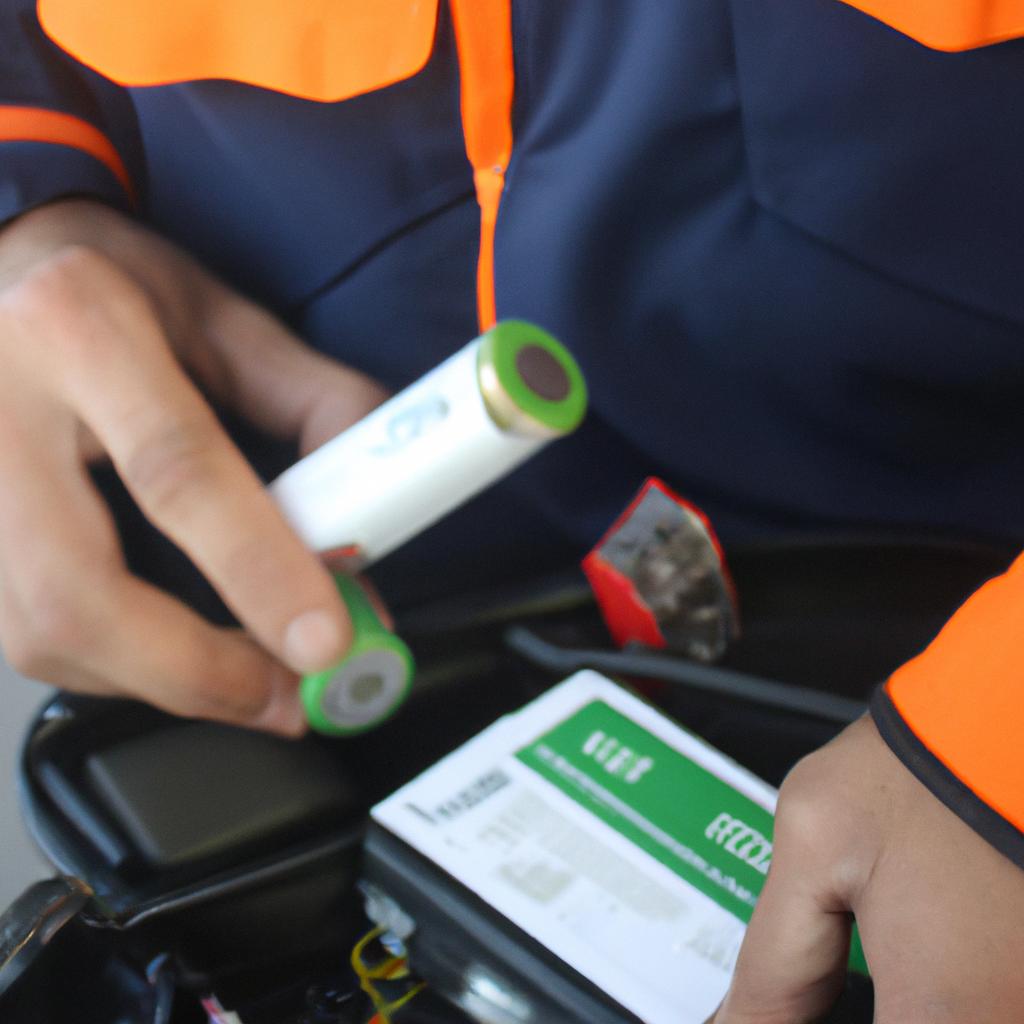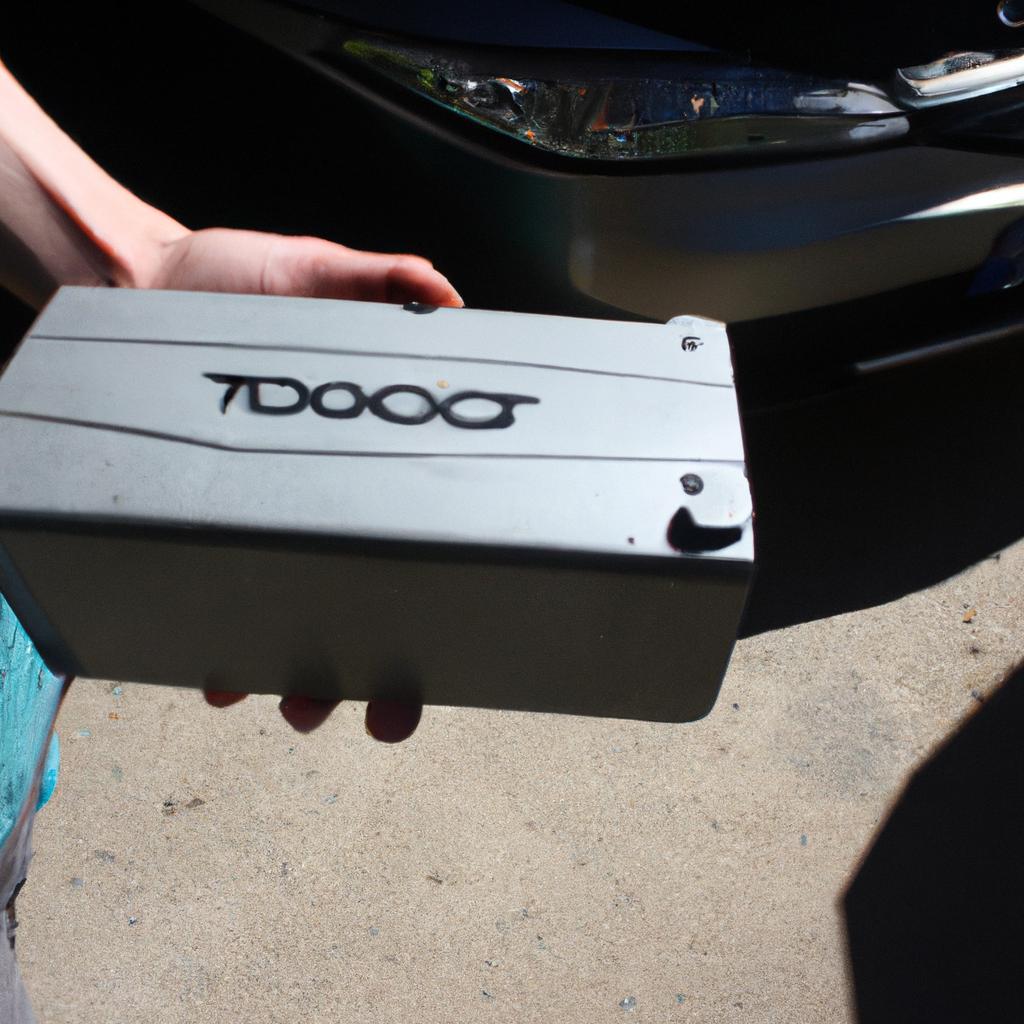The widespread adoption of electric vehicles (EVs) has become a critical aspect in the pursuit of sustainable transportation. However, to fully harness the potential benefits of EVs, it is essential to understand the underlying battery chemistries that power these vehicles. This comprehensive overview aims to provide an academic analysis and evaluation of various battery chemistries used in contemporary electric vehicle technology.
For instance, consider a hypothetical scenario where a consumer is contemplating purchasing an electric vehicle but is unsure about which type of battery chemistry would be most suitable for their needs. In this situation, having access to reliable information regarding different battery chemistries can aid the decision-making process. By examining each option’s advantages, limitations, performance characteristics, and environmental impact within an academic framework, consumers will gain valuable insights into choosing the optimal EV with a tailored battery chemistry solution.
Battery chemistries play a pivotal role in determining crucial aspects such as range, charging time, energy density, cost-effectiveness, safety considerations, and overall sustainability of electric vehicles. Therefore, exploring and understanding these technologies are fundamental steps towards fostering advancements in EV adoption on both individual and societal levels. Through this comprehensive overview, readers will acquire a deeper knowledge base regarding available battery chemistries for electric vehicles while being equipped with the necessary information to make informed decisions about their future electric vehicle purchase.
Lithium-ion Batteries
Lithium-ion Batteries
Electric vehicles (EVs) have gained significant attention in recent years as a sustainable and efficient alternative to traditional internal combustion engine vehicles. Central to the success of EVs is their battery technology, with lithium-ion batteries being at the forefront of this revolution. This section provides a comprehensive overview of lithium-ion batteries for electric vehicles.
To illustrate the significance of lithium-ion batteries, consider the case study of Tesla Motors. Since its introduction in 2008, Tesla’s Model S has become one of the most popular luxury electric sedans on the market. This success can be attributed partially to its advanced lithium-ion battery pack, which enables long-range driving capabilities and quick acceleration.
One notable feature of lithium-ion batteries is their high energy density, allowing them to store large amounts of electrical energy in a compact size. This characteristic is crucial for EVs as it directly impacts their range and overall performance. Furthermore, when compared to other rechargeable battery chemistries like lead-acid or nickel-metal hydride (NiMH), lithium-ion batteries exhibit significantly higher specific energy values.
In addition to their impressive energy density, lithium-ion batteries offer several advantages that make them highly desirable for electric vehicle applications:
- Fast Charging: Lithium-ion batteries can be charged rapidly compared to other alternatives.
- Long Cycle Life: These batteries possess a longer lifespan due to minimal capacity degradation over multiple charge-discharge cycles.
- Low Self-Discharge Rate: Lithium-ion batteries experience low self-discharge rates when not in use, minimizing energy losses during storage.
- Wide Temperature Range: They operate efficiently across a broad temperature spectrum, making them suitable for various climates and weather conditions.
| Advantages |
|---|
| Fast Charging |
| Wide Temperature Range |
Overall, lithium-ion batteries play a pivotal role in the success and widespread adoption of electric vehicles. Their high energy density, fast charging capabilities, long cycle life, low self-discharge rate, and wide temperature range make them an ideal choice for powering modern EVs. In the subsequent section, we will explore another prominent battery chemistry used in electric vehicles: Nickel Metal Hydride (NiMH) batteries.
Nickel Metal Hydride Batteries
Building upon the understanding of lithium-ion batteries, we now explore another prominent battery chemistry used in electric vehicles – nickel metal hydride (NiMH) batteries.
While lithium-ion batteries have gained significant attention in recent years, NiMH batteries continue to play a crucial role in certain applications. One notable example is their use in hybrid electric vehicles (HEVs). For instance, the Toyota Prius series has employed NiMH batteries as their primary energy storage solution for many years. This case study exemplifies the unique capabilities and advantages offered by NiMH technology.
Despite being overshadowed by lithium-ion counterparts, there are several reasons why NiMH batteries remain relevant:
- Cost-effectiveness: NiMH batteries tend to be more cost-effective compared to lithium-ion alternatives due to lower production costs and availability of raw materials.
- Safety: These batteries exhibit better thermal stability than lithium-ion cells, reducing the risk of overheating or combustion.
- Performance under extreme conditions: NiMH technology performs well at temperature extremes, making it suitable for applications where operating environments can vary significantly.
- Environmental impact: Nickel metal hydride batteries are relatively easier to recycle compared to other chemistries, contributing positively towards sustainability efforts.
To further illustrate the characteristics and performance attributes of NiMH batteries, consider the following table:
| Attribute | Lithium-Ion Batteries | Nickle Metal Hydride Batteries |
|---|---|---|
| Energy Density | High | Moderate |
| Power Density | High | Low |
| Cycle Life | Long | Moderate |
| Memory Effect | None | Present |
This brief comparison underscores how different battery chemistries possess distinct strengths that make them suitable for specific use cases within the realm of electric vehicles.
In summary, while often overlooked amidst the popularity of lithium-ion batteries, nickel metal hydride technology maintains its relevance in certain applications. Its cost-effectiveness, safety features, performance under extreme conditions, and recyclability contribute to its continued use in hybrid electric vehicles. Understanding the unique characteristics of different battery chemistries paves the way for further advancements in solid-state batteries.
Moving forward into the realm of solid-state batteries
Solid-State Batteries
Moving on from the discussion of Nickel Metal Hydride batteries, we now explore another promising technology in the field of battery chemistries for electric vehicles — Solid-State Batteries.
Solid-state batteries are an emerging alternative to traditional lithium-ion batteries. Their key feature is the replacement of liquid electrolytes with solid materials, leading to enhanced safety and improved energy density. To illustrate their potential, let us consider a hypothetical scenario where Company X develops a compact electric vehicle equipped with solid-state batteries. This vehicle boasts longer range capabilities due to increased energy density, allowing drivers to travel up to 400 miles on a single charge.
One advantage of solid-state batteries lies in their superior thermal stability compared to conventional lithium-ion counterparts. Unlike liquid electrolytes that can be flammable under certain conditions, solid-state electrolytes offer higher resistance to heat generation and propagation. Consequently, these batteries exhibit better resilience against thermal runaway events, reducing the risk of fire or explosion during operation.
- Enhanced safety through reduced flammability
- Improved energy density for extended driving ranges
- Longer lifespan resulting from decreased degradation rates
- Faster charging times enabling convenient refueling
Additionally, we can present a table highlighting some key characteristics of solid-state batteries compared to other chemistries:
| Battery Chemistry | Energy Density (Wh/kg) | Cycle Life | Charging Time |
|---|---|---|---|
| Lithium-Ion | 150-250 | 500-1000 cycles | 2-4 hours |
| Solid-State | >300 | >2000 cycles | <1 hour |
| Nickel-Metal Hydride | 50-90 | 500-800 cycles | 8-12 hours |
As seen in the table above, solid-state batteries exhibit significantly higher energy density and longer cycle life compared to other chemistries. Moreover, their charging times are considerably shorter, providing an advantage for electric vehicle owners who seek quick recharging options.
Looking ahead, the next section will delve into the advancements in Lithium-Sulfur batteries and their potential implications for electric vehicles.
Lithium-Sulfur Batteries
Solid-State Batteries have received significant attention in recent years due to their potential to overcome some of the limitations of traditional lithium-ion batteries. However, another promising battery chemistry that has gained traction is Lithium-Sulfur (Li-S) batteries. Li-S batteries offer a high theoretical energy density and are considered a potential alternative for electric vehicles (EVs).
To illustrate the capabilities of Li-S batteries, let’s consider a hypothetical scenario where an EV powered by Li-S batteries achieves a driving range of 500 miles on a single charge. This impressive range can be attributed to the high energy density of sulfur as compared to other commonly used electrode materials. Moreover, the use of lithium metal as the anode further enhances the energy storage capacity.
Despite these advantages, there are still challenges that need to be addressed before widespread adoption of Li-S batteries in EVs becomes feasible. One key challenge is the instability of sulfur during cycling, which leads to rapid capacity fade over time. Researchers are actively working on developing strategies such as incorporating protective coatings and utilizing advanced electrolyte systems to mitigate this issue.
In addition, it is important to address safety concerns associated with Li-S batteries. The formation of polysulfides during cycling can lead to the growth of dendrites and cause short circuits or even fires. Efforts are being made to develop effective separator designs and control mechanisms to inhibit dendrite formation and enhance overall battery safety.
Overall, Lithium-Sulfur batteries hold great promise for achieving higher energy densities in electric vehicles, potentially revolutionizing the industry. With continued research and development efforts focusing on improving stability and safety aspects, they could become a viable option for long-range EVs in the future.
![Emotional Bullet Points]
- Enhanced driving range: Potential for significantly increased mileage per charge.
- Environmental benefits: Lower carbon footprint due to reduced reliance on fossil fuels.
- Cost savings: Longer-lasting battery packs may result in lower maintenance costs for EV owners.
- Future scalability: Li-S batteries could enable the development of even more advanced energy storage technologies.
| Advantages | Challenges |
|---|---|
| Higher theoretical energy density | Rapid capacity fade during cycling |
| Potential cost savings in battery production | Safety concerns related to dendrite formation |
| Reduced reliance on fossil fuels | Limited cycle life compared to traditional lithium-ion batteries |
| Environmental benefits with lower carbon footprint | Need for further research and development |
Moving forward, let’s explore another intriguing battery chemistry known as Flow Batteries, which offer unique advantages for specific applications.
Flow Batteries
Building on the discussion of lithium-sulfur batteries, we now turn our attention to another promising battery chemistry for electric vehicles: flow batteries. Unlike traditional solid-state batteries, flow batteries use liquid electrolytes stored in external tanks, allowing for a decoupling of energy storage capacity and power output. One example that highlights the potential of flow batteries is their application in large-scale renewable energy integration.
Flow Battery Application Case Study:
Consider a hypothetical scenario where a remote island community heavily relies on intermittent renewable energy sources such as wind and solar power. To address the challenge of intermittency, a vanadium redox flow battery (VRFB) system is implemented. This VRFB system stores excess electricity generated during periods of high production and releases it when renewable energy generation falls short. By effectively managing fluctuations in supply and demand, this technology ensures uninterrupted power availability for the island’s residents while reducing reliance on fossil fuel-based backup generators.
Advantages of Vanadium Redox Flow Batteries:
- Enhanced scalability: The modular design of VRFB systems allows for easy scaling up or down depending on specific requirements.
- Long cycle life: Due to its unique mechanism involving reversible oxidation-reduction reactions at vanadium ions’ different valence states, VRFBs offer exceptional durability with minimal degradation over time.
- Rapid response time: With fast charge/discharge rates facilitated by continuous electrolyte circulation, VRFBs can quickly respond to sudden changes in demand, enhancing grid stability.
- Safety features: As all reactive components remain separate until needed during operation, VRFBs boast an inherently safe design that minimizes the risk of thermal runaway or catastrophic failure.
Table comparing Lithium-Sulfur Batteries and Vanadium Redox Flow Batteries:
| Lithium-Sulfur Batteries | Vanadium Redox Flow Batteries | |
|---|---|---|
| Energy density | High | Lower |
| Power output | Moderate | High |
| Cycle life | Limited (due to sulfur dissolution) | Long |
| Scalability | Relatively limited | Highly scalable |
As we explore various battery chemistries for electric vehicles, it is crucial to mention one emerging technology that shows great potential: graphene batteries. By harnessing the unique properties of this advanced material, graphene-based batteries offer exciting possibilities for enhancing energy storage capabilities in future EVs.
Graphene Batteries
Flow Batteries: A Promising Solution for Energy Storage
Imagine a world where electric vehicles (EVs) can travel hundreds of miles on a single charge, with the ability to recharge quickly and efficiently. This may not be an impossible dream, thanks to advancements in flow battery technology. Flow batteries offer significant potential as energy storage solutions for EVs due to their unique characteristics.
One notable example is the Vanadium Redox Flow Battery (VRFB), which has garnered attention in recent years. Its design allows for efficient charging and discharging by using two separate electrolyte tanks containing vanadium ions with different oxidation states. During charging, electricity converts one tank’s vanadium ions into a higher oxidation state while simultaneously reducing the other tank’s ions. The reverse occurs during discharge, enabling stored energy to power EVs over extended periods.
When evaluating flow batteries for EV applications, several factors come into play:
- Energy Density: Flow batteries typically have lower energy density compared to conventional lithium-ion batteries; however, ongoing research aims to improve this aspect.
- Power Density: Flow batteries excel in delivering high power output – essential for accelerating electric vehicles swiftly.
- Longevity: With proper maintenance and management, flow batteries demonstrate excellent long-term cycling performance, making them suitable for demanding EV requirements.
- Cost Effectiveness: While costs remain relatively high compared to traditional lead-acid or lithium-ion technologies, economies of scale and technological advancements are driving down prices.
To illustrate the comparison between various battery chemistries used in electric vehicles, consider the following table showcasing key attributes:
| Battery Chemistries | Energy Density | Power Density | Longevity |
|---|---|---|---|
| Lithium-Ion | High | High | Moderate |
| Lead-Acid | Low | Low | Low |
| Flow Batteries | Medium | High | Excellent |
| Graphene Batteries | High | Medium | Good |
This table highlights the relative strengths and weaknesses of different battery chemistries, emphasizing flow batteries’ high power density and longevity. As ongoing research continues to tackle challenges related to energy density and cost-effectiveness, flow batteries hold immense promise for powering electric vehicles in the future.
In summary, flow batteries present a compelling solution for energy storage in electric vehicles. The Vanadium Redox Flow Battery exemplifies this potential by offering efficient charging and discharging capabilities. While flow batteries currently face limitations concerning energy density and cost-effectiveness, their high power density and excellent longevity make them viable options for EVs. With continued advancements and research efforts, it is plausible that we will witness flow batteries playing a significant role in revolutionizing the way we power our electric vehicles.
 Sfeva
Sfeva



